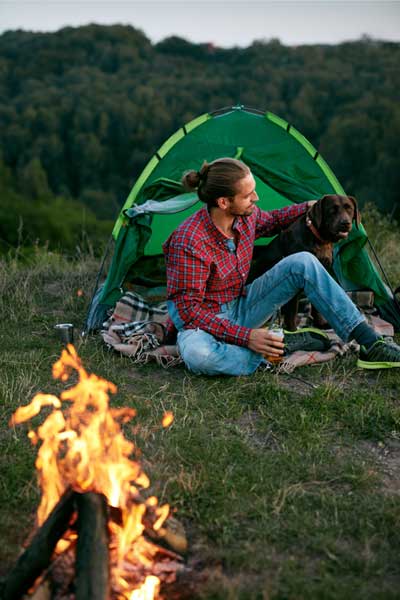Traveling Cross-Country With a Dog

As summertime approaches and we start planning our trips and vacations for 2020, a lot of people are going to be traveling by car vs. traveling by plane this year due to the Coronavirus pandemic. Instead of hitting up the resorts this year, some may choose to take the less-populated route and take a cross-country trip in their car. Whether you're going east to west or north to south, you're in for beautiful sights and views the US has to offer. While road tripping across the US isn't for everyone, for some people, driving is a way to relax. Especially on wide, open roads where it can seem like you're the only person within 100 miles. Taking a road trip alone can be a very rewarding, yet lonely adventure. If you're traveling without family or friends, it can quickly become a lonely experience, which is why some choose to bring along their furry companions. Bringing along a dog on a road trip provides just enough companionship and entertainment and is quickly becoming a popular thing to do. However, before you head off on your next great adventure there are things you need to do to be prepared for all the surprises that could pop up along the way.
MAKE SURE YOUR DOG IS COMFORTABLE IN THE CAR
Before you start planning you trip, it is important that your first make sure your dog is comfortable in the car. To help acclimate your dog to the car, make sure your dog has their own space in your car to sit, lay down, and relax. To train your dog for long car rides, start out by taking a two to three hour car ride. If your dog happily jumps into the car with no issue, sticks his head out the window, wags his tail, and eventually lays or sits down and is content, then your dog is ready for a cross country adventure. If your dog is excessively panting or whining the entire time and seems stressed out, you may want to rethink taking your dog on a cross country trip. Some dogs just aren't cut out for it and would be much more comfortable and happier in their own home.
PREPARE YOUR DOG FOR TRAVEL
Now that you know if your dog is comfortable in a car, there are a couple more things you should do to prepare your dog. First, schedule a wellness checkup with your vet. You'll want to make sure your dog is up to date on all his vaccines and is physically well enough to travel for a long period of time in a car. You can also use this visit to ask about ways to treat dog nausea because even dogs can get car sick. If your dog is not already micro-chipped, think about getting it done before your take off on your trip. It's important to be prepared if you and your dog somehow become separated during the trip. If he's micro-chipped, he will be scanned upon pick up and his rescuers will be able to reach you easily. If your dog is not micro-chipped, make sure that your dog has identification tags on a secure, fit collar. You should also get a couple extra collars and ID tags made just in case your dog loses his collar.
After visiting the vet and getting a clean bill of health, it's time to start planning your trip. It takes almost 48 hours to drive by car from the west coast to the east coast of the US. That's about six 8-hour days of driving. However, nobody wants to rush through traveling cross country. So, take your time. Drive 4-6 hours a day instead of 8. Enjoy the slower pace of the back roads and the sights all around you. Be sure to carefully plan out your trip and where you'll sleep each night so that your dog does not get left out. Search for pet-friendly hotels, rest stops, and camping sites. That you, you know you won't be turned away or asked to leave because of your dog. La Quinta and Best Western, two popular hotel chains with hundreds of locations across the US, allow up to two dogs per room free of charge. You may have to pay an extra deposit in case your dog does any damage, but most places give it back to you if no damage is done. Be sure to plan for plenty of restroom stops so that there are no accidents in the car. But most of all, make time to stop and relax, and enjoy your trip. You and your dog will make memories that will last a lifetime.
PACK UP YOUR DOG'S TRAVEL SUPPLIES
The last step in preparing for a cross-country trip with your dog is getting their travel supplies ready. The basic travel supplies include:
- Extra collars & ID tags
- Leashes
- Waste bags for poop pick up
- Food and water bowls
- Treats
- Flea & tick control
- Any medication your dog may be on
- First aid kit
- Your dog's documentation (i.e. vaccination records, registrations, etc.)
Your dog will need to eat and drink plenty of water during your trip. Be sure to have a portable food and water bowl that you can set out at each stop for your dog to eat and drink. Store your pet's food in a travel-sized, air-tight food storage container so that your dog's food stays fresh the entire trip. Take a couple of gallons of water with you so that your dog still has access to clean water during the trip.

Be sure to bring along a bed or blanket for your pet to sleep on at night. Bringing along a travel bed for your dog will let your dog know that he has a designated, safe place to sleep each night and will provide a much better night of sleep vs. sleeping on the cold, hard ground. There are zip-up and roll-up travel beds available that are lightweight and easy to pack up in the morning when it's time to get back on the road.
Don't forget to pack your dog's favorite toys for fun games of fetch or tug on your adventure! Your dog will need you to stop every few hours so that he can stretch out his legs. Play fun games of fetch during this time to help your dog stretch his legs and well as relieve some energy. This will tire him out and give you a chance to get some miles in while he sleeps.
HOW OFTEN SHOULD I STEP TO LET MY DOG USE THE RESTROOM?
Once you've packed up both your and your dog's travel supplies and packed up your car, it's time to hit the road. Generally, you should stop every 2-3 hours to give your dog a potty break. For smaller breeds, you may need to stop more frequently (every hour and a half) due to your dog's smaller bladder. Also, be sure to keep your dog's age in mind. Sometimes, older dogs cannot hold it as long. So be sure to know your dog's potty schedule and plan for stops along the way.
POPULAR DOG-FRIENDLY ACTIVITIES YOU CAN DO ON YOUR TRIP

One of the most popular activities you can do with your dog on a road trip is to stop and take a hike. If you plan on stopping at a state or national park for your hike, be sure to call ahead to make sure they allow dogs. Not all national or state parks allow dogs because of the wildlife that lives in the park. Another fun activity you can do with your dog is camping. Staying out under the stars, close to nature is always a great way to bond with your dog. You and your dog can also take a swim in a stream or lake to cool off during the hot summer months. If you're wanting human interaction, find a restaurant or bar with a dog-friendly patio. You and your dog will enjoy the company. There are plenty more activities you can do with your dog. But be sure to plan so that your dog is always included.
NEVER LEAVE YOUR DOG ALONE IN YOUR CAR
It's very important that during hot spring and summer months, you never leave your dog alone in the car… even if the windows are cracked. The inside of a car can quickly exceed temps over 110 degrees. Your dog can suffer from heat exhaustion or a heat stroke if left alone for too long. If you know you're going to want to do an activity where dogs are not allowed, research local doggy daycares or pet sitters in the area so that you can enjoy your time, knowing that your dog is safe.
Sources:
Previous article

Next article

Related posts
View all-

What Supplies Do First-Time Cat Owners Need?
Bringing home a new cat is exciting, but making them feel safe and comfortable takes more than love. First-time cat owners must prepare with the right supplies to ensure a smooth transition. From a litter box to cat food and a warm bed, having the basics ready can help your new kitty settle in faster. This guide covers everything a new cat owner needs to make their new pet feel at home.
Read Article -

Celebrate National Pet Adoption Day
Adopt a Shelter Pet Day occurs every year on April 30. This special day is a nationwide initiative to raise awareness about pet adoption and encourage people to open their hearts and homes to shelter animals in need. Millions of cats and dogs enter animal shelters every year, hoping for a second chance at life.
Read Article -

3 Ways a New Cat Can Change Your Life for the Better
If a cat hits you with Cupid’s arrow, Petmate can help you uncover why a feline friend belongs in your home and the bedding for cats to keep them comfortable. Whether you were planning on a new addition to the family or the cat distribution system placed one of them at your feet, there are many ways a cat can change your life for the better.
Read Article



